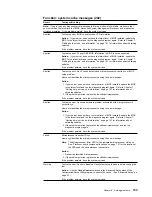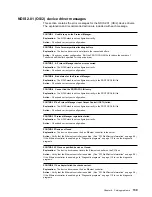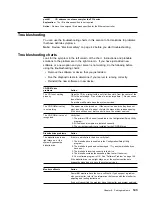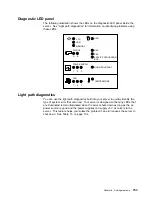
Memory problems
Action
The amount of memory
displayed is less than the
amount of memory
installed.
Verify that:
1. The memory modules are seated properly.
2. You have installed the correct type of memory (see “Installing
memory-module kits” on page 65).
3. If you changed the memory, you updated the memory configuration
with the Configuration/Setup Utility program. For information about
using the Configuration/Setup Utility program, see “Using the
Configuration/Setup Utility main menu” on page 21.
4. All banks of memory on the DIMMs are enabled (see “Memory
Settings” on page 29). The server might have automatically disabled
a DIMM bank when it detected a problem, or a DIMM bank could
have been manually disabled.
If the problem still exists, run the memory diagnostic program. The
system might have detected a bad memory module and automatically
reallocated memory so that the server could continue to operate. If the
memory tests fail, have the system serviced or replace the failing DIMM.
Option problems
Action
An IBM option that used
to work does not work
now.
Verify that all of the option hardware and cable connections are secure.
If the option comes with its own test instructions, use those instructions to
test the option.
If the failing option is a SCSI option, verify that:
1. The cables for all external SCSI options are connected correctly.
2. The last option in each SCSI chain, or the end of the SCSI cable, is
terminated correctly.
3. Any external SCSI option is turned on. You must turn on an external
SCSI option before turning on the server.
If the problem still exists, have the system serviced.
An IBM option that was
just installed does not
work.
Verify that:
1. The option is designed for the server. Refer to Chapter 7, “Getting
help, service, and information” on page 161 for information about
obtaining ServerProven
compatibility information from the World
Wide Web.
2. You followed the installation instructions that come with the option.
3. The option is installed correctly.
4. You have not loosened any other installed options or cables.
5. You updated the configuration information in the Configuration/Setup
Utility program. Whenever memory or an option is changed, you must
update the configuration. For information about using the
Configuration/Setup Utility program, see “Using the
Configuration/Setup Utility main menu” on page 21.
If the problem still exists, have the system serviced.
Parallel port problems
Action
The number of parallel
ports displayed is less
than the number of
parallel ports installed.
Verify that:
1. Each port is assigned a unique address.
2. The parallel-port adapter, if you installed one, is seated properly.
If the problem still exists, have the system serviced.
146
IBM xSeries User's Reference
Содержание eServer 240 xSeries
Страница 1: ...User s Reference xSeries 240...
Страница 26: ...16 IBM xSeries User s Reference...
Страница 50: ...40 IBM xSeries User s Reference...
Страница 116: ...106 IBM xSeries User s Reference...
Страница 170: ...160 IBM xSeries User s Reference...
Страница 180: ...170 IBM xSeries User s Reference...
Страница 219: ...IBM Part Number 21P9014 Printed in the United States of America 21P9 14...
















































